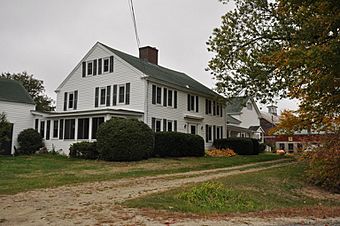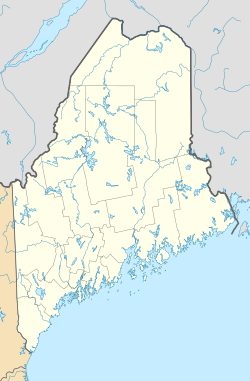Lower Alewive Historic District facts for kids
Quick facts for kids |
|
|
Lower Alewive Historic District
|
|
 |
|
| Location | Kennebunk, Maine |
|---|---|
| Area | 208 acres (84 ha) |
| Built | 1790 |
| Architectural style | Federal, Greek Revival |
| NRHP reference No. | 94000178 |
| Added to NRHP | March 24, 1994 |
The Lower Alewive Historic District is a special area in northwestern Kennebunk, Maine. It's like a time capsule showing what rural farm life was like long ago. This district includes four old farm properties. They were all started in the 1750s. These farms are located between the Kennebunk River to the north and a road with several names (Russell Farm Road, Emmons Road Extension, and Winnow Hill Lane) to the south. This historic district was added to the National Register of Historic Places in 1994. This means it's recognized as an important place in American history.
Contents
Exploring the Lower Alewive Historic District
The "Alewive" area is inland from the coast of Kennebunk. People first settled here in the 1750s. All four farms in this district were started around that time. They stretched along what became known as Emmons Road. This road ran east and then south from what is now Maine State Route 35 towards the center of Kennebunk village. Two of these farms were even owned by members of the Emmons family!
The James Smith Farm: A Glimpse into the Past
The farm furthest to the west belonged to James Smith. He bought his 50 acres (about 20 hectares) in 1753. People used to think his house was built in 1753 too. But experts who studied how it was built believe it dates to about 1800. The house might have been a much larger version of an older building. This farm stayed in the Smith family, used for farming, until the early 1900s.
The Walker-Russell Farm: Changing Hands and Styles
Just east of the Smith farm is the Walker-Russell Farm. Samuel Littlefield, Jr., bought its 40 acres (about 16 hectares) in 1753. Later, in 1797, John Walker bought the property. He likely built the beautiful Federal style house soon after.
In 1874, Eliphet Walker sold the farm to Cyrus Russell. Mr. Russell added some fancy Italianate decorations to the house. These included decorative brackets. The farm also has several other old buildings. One barn might even be from the early 1800s!
The Seth Emmons Farm: A New Look
The Seth Emmons Farm is located east of the Walker-Russell Farm. Its 54 acres (about 22 hectares) were also first bought by Samuel Littlefield, Jr., in 1753. But John Taylor bought it next and built the first buildings there.
In 1840, Seth Emmons bought the farm. He tore down Taylor's house and built the current house. This new house was in the Greek Revival style. It also has some Italianate decorations added later, just like the Walker-Russell Farm. There's also a barn on this property that dates back to the early 1800s.
The Collins Emmons Farm: Expanding a Home
The Collins Emmons Farm is the easternmost of the four properties. Stephen Larrabee bought its 50 acres (about 20 hectares) in 1753. In 1852, Seth Emmons and his two sons bought this land. The older son, Collins, inherited this farm. His brother, Seth T. Emmons, inherited the farm to the west.
The house on Collins's farm was originally a smaller Cape-style farmhouse. It had a chimney in the middle. Collins Emmons made it much bigger. He added features in the Greek Revival style, making it a grander home.
These four neighboring farms are a very important part of Kennebunk's farming history. They show us how land was used and how people lived in the 1700s and 1800s.



